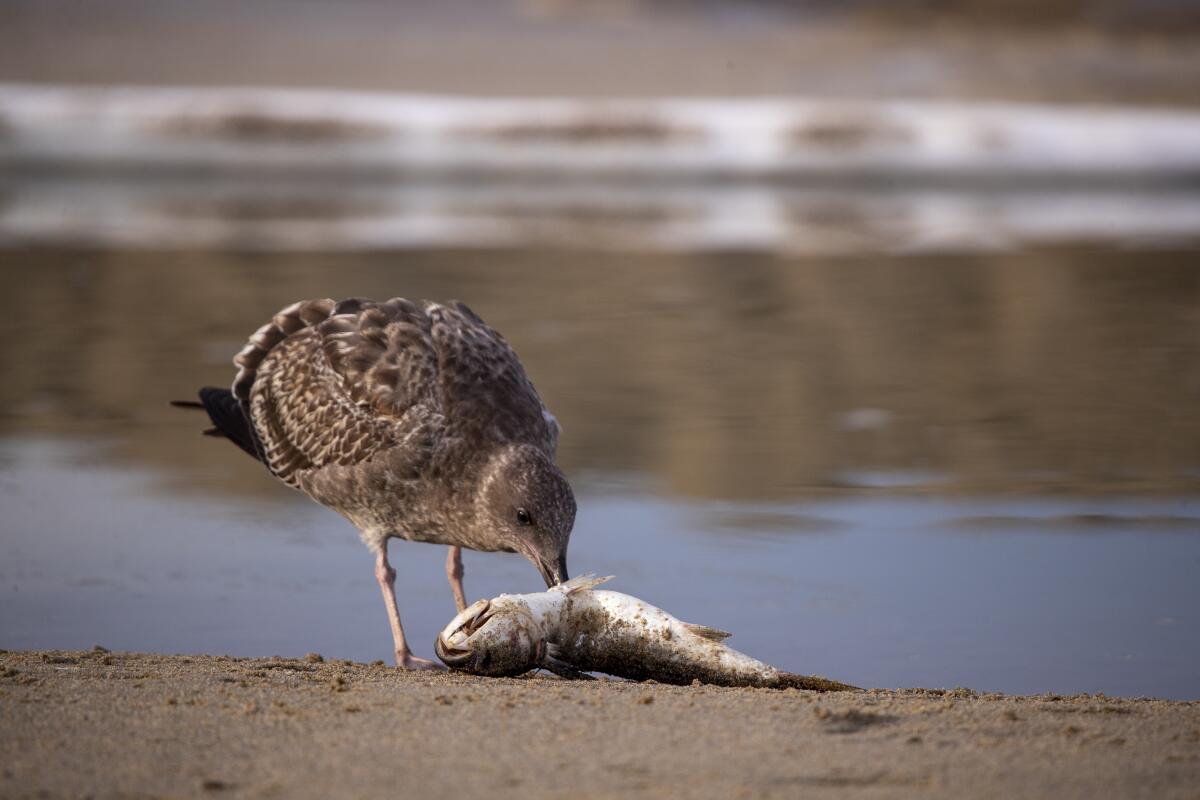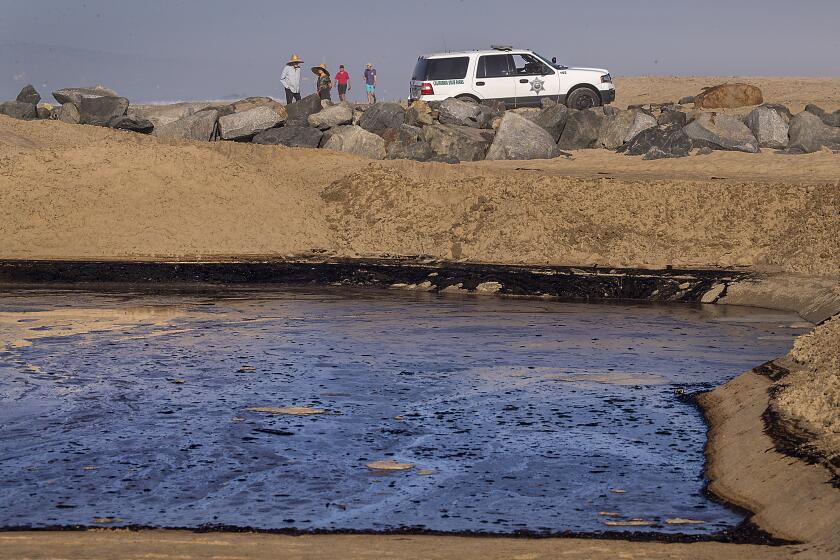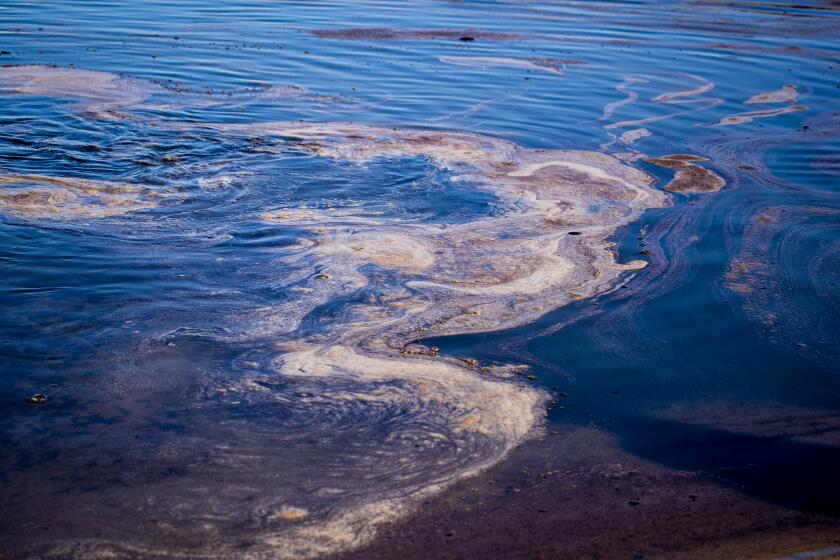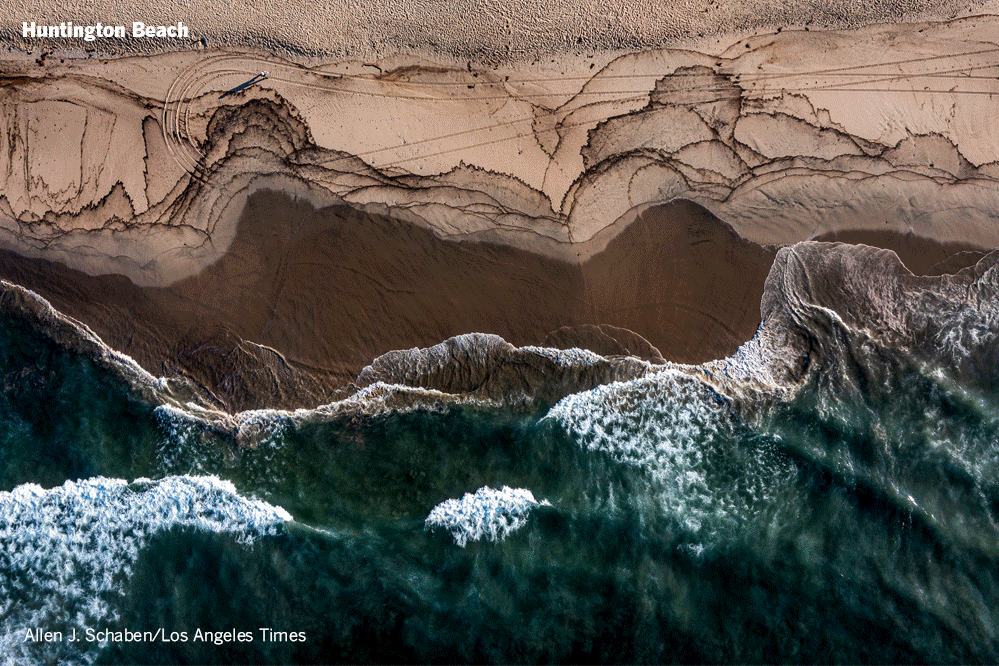Opinion: Eerily empty beaches and globs of oil. The full impact of the California oil spill is yet unknown

- Share via
The shallow water of the Bolsa Chica wetlands in northern Huntington Beach looked clean Monday afternoon. Turns out it was pretty clean.
A boom that had been stretched across its outlet to the sea had prevented oil from getting in, a Bolsa Chica expert explained to me Monday. It helped that the wetlands are slightly north of the offshore spill that occurred over the weekend, and the current has been taking the oil south.
But the air didn’t smell clean. As soon as I got out of the car in the parking lot, I was hit by a reek of gasoline and asphalt, as though a paving project and a fuel truck had met in a bad interaction. And there were very few birds — some marbled godwits pecked at the shoreline here and there, and a few snowy egrets hunched in their usual isolated and disapproving position, as though to comment on what a mess humans had made, yet again.
Bolsa Chica, a major stop along the Pacific Flyway, is generally low on birds this time of year. Fortunately for avian life, the spill occurred after the summer birds have decamped south and before the winter birds arrive in November. Still, it was explained to me, you’d normally see some of the seabirds fly in for their daily visits. It’s not clear what has happened to them, but if they had been oiled by the spill, they couldn’t fly anywhere.
The Orange County coastline has become the latest casualty to the nation’s unhealthy dependence on oil.
When I’m not writing for The Times, I’m a certified naturalist for the local wildlife parks and for the American Cetacean Society, as well as a tidepool docent. I kept track of the first replanting of kelp in Crystal Cove and Laguna Beach starting in 2002; it was a wildlife success story considering that by the 1990s, the kelp forests had been diminished by about 80%. In my town, Laguna Beach, there was so much excitement about the kelp beds’ return that the city launched an annual kelp festival.
Could the oil spill undo all that effort to regrow the kelp beds? Are pelicans, after making a spectacular comeback in recent decades, going to dive into a sheen of oil to find fish? Will whales or dolphins be affected as they come up through a thin veil of oil to breathe?
My nature work didn’t prepare me to fully understand the effects of a pipeline leak like this one, which sent as much as 144,000 gallons of oil into the ocean. The internet can figure out in less time than it takes a pelican to flap its wings whether I’ve been shopping for lightweight hiking boots and blast me with ads for them, but we don’t seem to have the technology for sensors to detect motion and fractures on pipelines and send out instant alarms. Or to fully understand exactly how an oil spill will affect the environment.
I decided Monday to drive from Bolsa Chica to Laguna Beach — the southernmost place where oil was showing up onshore — looking for answers. There weren’t many. The beach parking lots along Pacific Coast Highway were eerily devoid of cars, as they were in the early days of the pandemic. Most of the beaches were closed to the public — and this time, people were listening. The sand looked normal from a distance, but up close, globs of tar dotted the shoreline. The ocean looked fine except for the skimmers and, of course, the usual lineup of cargo ships that from a distance look like giant floating hotels. But you could see the oil sheen here and there, if you looked carefully enough, and could smell petroleum for miles. The fenced-in section at the southernmost point of Huntington Beach, where the endangered snowy plover nests in the sand, looked about the same as ever.
The massive oil spill from a 126,000-gallon leak off the Orange County coast is moving south, threatening marine protected areas as well as popular beaches.
Talbert Marsh, several miles south of Bolsa Chica, was more heavily affected. The oil found its way in. But by Monday, a boom had been laid across the water, separating the clean area from the contaminated; gulls and cormorants huddled on the clean side. It hadn’t been quite as catastrophic as expected, one worker said as he walked by. No one was reporting how many tarred animals had been brought into the Huntington Beach Wetlands and Wildlife Care Center — nestled next to a massive power plant — for cleaning, but at the tightly gated entrance, families stopped and emptied their trunks of donations: Dawn dishwashing liquid, famous for its wildlife de-oiling properties; nitrile gloves; masks.
On Balboa Peninsula in Newport Beach, the store of whale-watching operation Davey’s Locker was open but empty of people. No boats were going out; the city had closed the harbor. The man behind the counter said they’d been seeing a couple of blue whales in recent days, and one minke. The timing of the spill was lucky for whales, too. A few gray whales pass through this time of year on their way from Alaska to Mexico, but the numbers are small, and the southward migration is generally far out to sea; it’s starting in January, on the way back north with their young, that they hug the coastline more.
But dolphins are around all the time and have already been seen cavorting in the slick. Researchers know from the Deepwater Horizon spill in the Gulf of Mexico that dolphins can develop lung and heart disease from repeated exposure to oil.
It takes a while for injuries to marine mammals to manifest — if they do at all. There’s some evidence that whales are seldom badly affected by spills. At the Pacific Marine Mammal Center in Laguna Canyon on Monday, staff were in waiting mode for seals or sea lions to be brought in. As of Tuesday morning, the center reported that no de-oiling organizations had received injured marine mammals.
It’s also not well known how the spill might affect the kelp beds that dedicated people worked so hard to bring back, planting them on the ocean floor with their roots growing on pieces of tile.
There were some small balls of tar near the tidepools in North Laguna. That is worrisome. Most tidepool wildlife — anemones, barnacles, mussels and the like — can’t escape oily water the way fish can. A boat that operates a device for skimming oil floated offshore. Laguna is a Marine Protected Area, where fishing isn’t allowed from shore. All this effort to restore fish populations — will that be set back by this spill? It is possible, according to the National Oceanic and Atmospheric Administration.
Bolsa Chica, the northern start of my trip, bears long witness to the varying ways humanity treats nature.
It was inhabited by Native Americans for about 9,000 years before they were displaced by Spanish settlements; the trace they left behind consisted mainly of notched cogstones, the purpose of which has never been determined. The wetlands teemed with marine life and birds.
But in the mid-1800s, white businessmen from Los Angeles cut off this coastal marsh in Huntington Beach from the sea, in order to turn it into a duck hunting club. That was ruinous for many other species that used this as their nesting or overwintering grounds. Oil was discovered, and pumpjack wells went up, looking a little like giant shorebirds themselves, slowly pecking at the ground. Levees were constructed to access the wells.
The oil likely will continue to encroach on Orange County beaches for the next few days, officials said.
A century later, a long battle would ensue over plans to build in the area and create a marina. But environmental heads prevailed, and the dam was removed about 15 years ago, along with a tremendous amount of built-up sand. Islands were built to accommodate endangered least terns, and native vegetation was planted. Then everyone held their breath. And the sea life returned, and with it, the birds.
It will probably take years for the effects of the pipeline spill to show themselves. So that’s what we’re all doing now — holding our breath.
More to Read
A cure for the common opinion
Get thought-provoking perspectives with our weekly newsletter.
You may occasionally receive promotional content from the Los Angeles Times.














